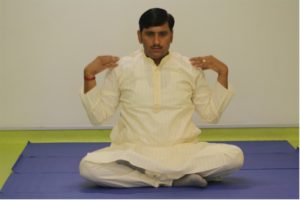
By John M. de Castro, Ph.D.
“The ancient practice of yoga nidra, also known as yogic sleep, is a meditative practice that results in conscious deep sleep. Current research suggests that yoga nidra can help relieve menstrual problems, diabetes symptoms and post-traumatic stress disorder (PTSD).” – Elaine Gavalas
Menstrual disorders are associated with disruptive physical and/or emotional symptoms just before and during menstruation, including heavy bleeding, missed periods and unmanageable mood swings. Symptoms can include abnormal uterine bleeding, which may be abnormally heavy or absent or occurs between periods, painful menstrual periods, premenstrual syndrome, or premenstrual dysphonic disorder (depression). These disorders are all very common and most women experience some of these symptoms sometime during their premenopausal years, while around 20% experience them throughout their fertile years.
Yoga has documented benefits for the individual’s psychological and physical health and well-being. It has also been shown to improve menstrual problems. Yoga, however, consists of a number of components including, poses, breathing exercises, yoga nidra (meditation), concentration, and philosophy/ethics. So, it is difficult to determine which facet or combination of facets of yoga are responsible for which benefit. Hence, it is important to begin to test each component in isolation to determine its effects.
In today’s Research News article “Psycho-Biological Changes with Add on Yoga Nidra in Patients with Menstrual Disorders: a Randomized Clinical Trial.” See:
or below or view the full text of the study at:
http://www.ncbi.nlm.nih.gov/pmc/articles/PMC4794540/
Rani and colleagues randomly assigned women who displayed menstrual disorders for more than 6-months to either a yoga Nidra or treatment as usual group. Yoga nidra is generally practiced while lying on the back on a mat on the floor with the arms out at the sides and the palm facing up. This is the what’s known as the corpse pose in yoga. It is generally a deep guided meditation practice. It usually begins with a systematic body scan meditation and then moves into a deep meditative state. The most easily observable effect of the yoga nidra practice is the extremely deep relaxation of the nervous system and healing of the body by allowing it the rest and recharge it usually lacks in our all too busy lifestyles. Yoga nidra produces a state of deep relaxation and sedation without the individual actually going to sleep.
At baseline Rani and colleagues measured psychological general well-being, and a variety of hormone levels. The yoga nidra group then received 30-35-minute yoga nidra, 5 days per week for 3 months and practiced at home for the subsequent 3 months. Measurements were then repeated at the end of the 6-month program. Control participants received their normal medical treatments during the 6-month period. They found that the yoga Nidra group showed significant improvements in anxiety, depression, positive well-being, general health, and vitality while the control group did not. Similarly, they found that the yoga Nidra group had significant decreases in 4 hormone levels; thyroid-stimulating hormone, follicle-stimulating hormone, luteinizing hormone, and prolactin. Hence, yoga Nidra produced positive benefits for psychological well-being and also for endocrine (hormonal) function.
These are exciting findings. Yoga Nidra practice improved psychological well-being in women with menstrual disorder. Yoga practice and meditation practice have these same benefits for practitioners. But, it’s interesting that these psychological benefits can be produced by yoga nidra practice alone. The findings of decreased hormone levels are significant. Pituitary hormones, follicle stimulating hormone, luteinizing hormones, prolactin and thyroid hormones are very much involved in the menstrual cycle and are required for normal development of ova. Yoga Nidra practice may be helping with menstrual disorder by producing better regulation of these crucial hormones. Future research will be required to investigate this idea.
It is important to note that the control group did not receive any new active treatment. It is possible that the effects observed were not due to yoga Nidra, but to the expectations of the participants that the yoga nidra would improve their disorder. It will be important for future research to include and active or placebo control condition.
Regardless, the results suggest that well-being can be improved in women with menstrual disorder with yoga nidra.
“Yoga nidra for me is like a ‘super nap’ that recharges me in no time. It is a complete rejuvenation package – a must to relieve ourselves of daily stress in today’s busy world.” – Pritika Nair
CMCS – Center for Mindfulness and Contemplative Studies
This and other Contemplative Studies posts are also available on Google+ https://plus.google.com/106784388191201299496/posts
Study Summary
Rani, K., Tiwari, S. C., Kumar, S., Singh, U., Prakash, J., & Srivastava, N. (2016). Psycho-Biological Changes with Add on Yoga Nidra in Patients with Menstrual Disorders: a Randomized Clinical Trial. Journal of Caring Sciences,5(1), 1–9. http://doi.org/10.15171/jcs.2016.001
Abstract
Introduction: Menstrual disorders are common problems among women in the reproductive age group. Yuga interventions may decrease the physical and psychological problems related to menstrual disorders. The present study was aimed to assess the effect of Yoga Nidra on psychological problems in patients with menstrual disorders.
Methods: A total number of 100 women recruited from the department of obstetrics and gynecology and were then randomly allocated into two groups: a) intervention received yogic intervention and medication for 6 month, and b) control group received no yogic intervention and they only received prescribed medication). Psychological General Well-Being Index (PGWBI) and hormonal profile were assessed at the time of before and after six months on both groups.
Results: The mean score of anxiety, depression, positive well-being, general health, and vitality scores, as well as hormonal levels, in posttest were significantly different in intervention group as compared with pretest. But there was no significant difference in control group.
Conclusion: Yoga Nidra can be a successful therapy to overcome the psychiatric morbidity associated with menstrual irregularities. Therefore, Yogic relaxation training (Yoga Nidra) could be prescribed as an adjunct to conventional drug therapy for menstrual dysfunction.
http://www.ncbi.nlm.nih.gov/pmc/articles/PMC4794540/








